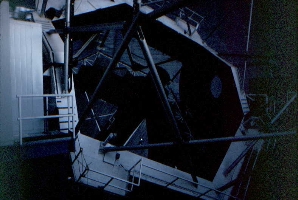Telescopes I've Seen - Mauna Kea, Hawaii
Mauna Kea Observatories -
Mauna Kea, Island of Hawai'i
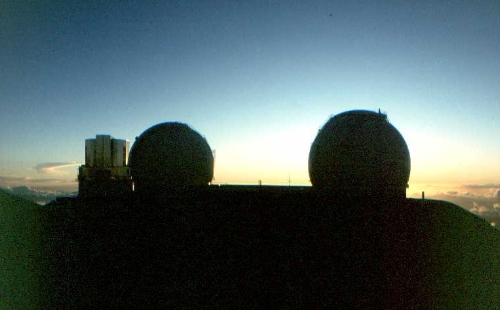
Taking advantage of the high altitude and smooth airflow afforded
by its unique location on a very tall mid-ocean volcano,
Mauna Kea hosts the largest collection of optical and infrared
telescopes on the planet, operated by groups worldwide. Aside from
the NASA Infrared Telescope Facility and
the UK/Canadian/Dutch James Clerk Maxwell
telescope, these facilities include:
The two 10-meter Keck telescopes
The 8.2-meter Subaru telescope
the 8.1-meter Gemini North telescope
the 3.8-meter UK Infrared Telescope
the 3.6-meter Canada-France-Hawaii
telescope
the University of Hawaii's 2.2-meter telescope
the 10.4-meter dish of the Caltech Submillimeter Observatory
Mauna Kea is a unique environment. The only macrosopic lifeforms
I've seen on the summit are astronomers and Wekiu beetles, which seem to
live off the carcasses of less hardy arthropods blown up on ill
winds. Otherwise the ground looks rather like pictures of Mars. The daytime
views aren't bad - Maui to the north, and sometimes to the south steam from
lava pouring into the Pacific (only place I know of where lava is a source
of light pollution). Here are some views of the summit from
IRTF observing visits in 1996 and 1997
(when Gemini North was still only a steel dome framework). There was
plenty of moonlight for nighttime views, since IR work doesn't
mind that much.
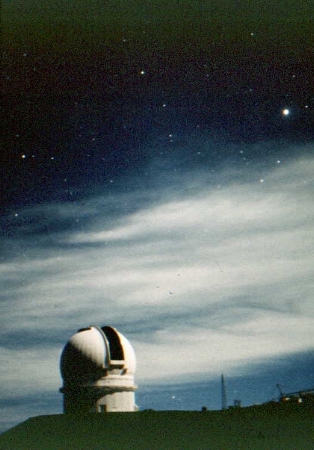 |
The 3.6-meter Canada-France-Hawaii telescope (CFHT), in its trademark
onion dome. The excellent site plus careful attention to optics and
airflow made this the first sizeable telescope to regularly
deliver crisp subarcsecond images of faint targets. That's Arcturus and
the rest of southern Bootes rising behind the dome. |
| The University of Hawaii has long operated this 2.2-meter
telescope (otherwise unnamed) at the summit. The enclosure for
an instrument-change crane gives the dome an unmistakeable snout.
The telescope has been recently notable for its roles in finding
Kuiper-belt objects and deep infrared surveys. Sorry about thise
scanner-artifact stripes on the corrugated sides - as bad as
wagon wheels in an old Western movie. |
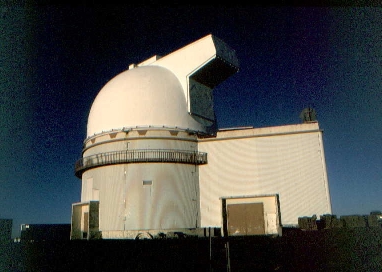 |
| I was lucky enough to follow Fred Chaffee on his admiral's tour of
the Keck domes, and got these shots of the two telescopes as a night's
work was starting. Aside from the sheer aperture, they stand out for
the mechanical design - compared to more traditional telescopes, they might as
well be made of spiderweb. This light construction means they also move
unusually fast. |
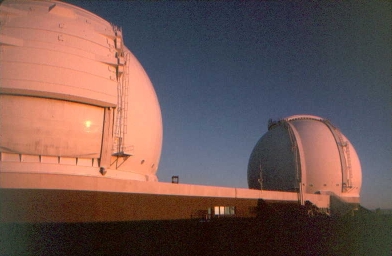 |
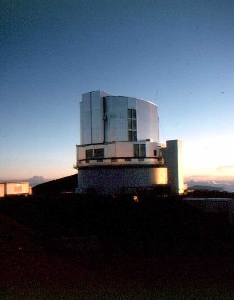 |
This enclosure, next to the Keck domes, houses the Subaru
telescope of the Japanese national observatory. This is a very well-instrumented
telescope, the only one of the generation of 8-m telescopes with wide-field
imaging available as well as deep spectroscopy (IR work is a specialty).
They've gone to considerable lengths to keep observers and other heat sources
away from the telescope, including industrial robots to change
secondary mirrors remotely. The control room is on a separate building
just downhill. |
| UKIRT was the first 4-m class dedicated IR telescope, and
a continual upgrade process has left it capable of delivering subarcsecond
images with IR imagers. Like the IRTF, it uses a yoke mount, sacrificing
coverage near the north pole for compactness and stability. |
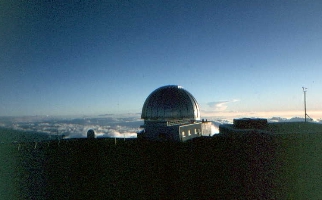 |
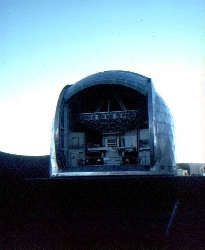 |
The 10-meter dish of the Caltech Submillimeter Observatory sits
down below the summit im "Millimeter Valley", more protected from
the wind in a useful place for large instruments that don't need
the summit airflow for optical seeing. The edge of the dish can
just be seen as it points upward while the enclosure is opened. |
Telescope Collection
Bill Keel's Home Page |
Astronomical Image Gallery |
Image Usage and Copyright Info |
UA Astronomy
keel@bildad.astr.ua.edu
Last changes: 3/2001 © 2001
